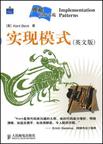实现模式
2008-11
人民邮电出版社
Kent Beck
157
无
这是一本关于如何写好代码的书。。 如果你不认为写好代码是一件重要。困难并且有趣的事,请立即放下这《实现模式》。 什么是好的代码?可以工作的。性能良好的。不出bug的代码,就是好的代码吗? 所谓好的代码,除了其他所有要求以外,还应该清晰准确地传达写作者的想法。 MartinFowler在《重构:改善既有代码的设计》里说,“任何一个傻瓜都能写出机器能懂的代码。好的程序员应该写出人能懂的代码。” 如果你不同意这句话,请立即放下这《实现模式》。因为这是一本关于如何用代码与他人(而非机
在本书中,作者将自己多年形成的编程习惯以及阅读既有代码的体验凝练成了编程中的价值观、原则和77种实现模式。 沟通、简单和灵活的价值观应当被所有开发人员所铭记。局部影响、最小化重复、将逻辑与数据捆绑等原则同样是通用性的指导思想,比价值观更贴近编程场景,在价值观和模式之间搭建了桥梁。在77个实现模式中,每一个模式都覆盖了编写简洁、清晰、易扩展、易维护的代码这一原则的某个方面。它们为日常的编程提供了丰富翔实的参考依据,并告诉大家这些代码如何为降低沟通成本和提高有效产出提供保障。 本书适用于各个阶段的开发者群体,刚刚涉足软件开发领域的新人能够透过大师的眼睛来看待编程,了解编程的价值观与原则;而具有丰富经验的资深工程师则可以通过这些模式进行反思,探究成功实践背后的意义。把价值观、原则和开发实践结合之后,日常开发工作便会以崭新迷人的形式呈现在我们面前。
Chapter 1: Introduction 1 Tour Guide 3 And Now 4Chapter 2: Patterns 5Chapter 3: A Theory of Programming 9 Values 10 Communication 10 Simplicity 11 Flexibility 12 Principles 13 Local Consequences 13 Minimize Repetition 14 Logic and Data Together 14 Symmetry 15 Declarative Expression 16 Rate of Change 17 Conclusion 18Chapter 4: Motivation 19Chapter 5: Class 21 Class 22 Simple Superclass Name 23 Qualified Subclass Name 24 Abstract Interface 24 Interface 26 Abstract Class 26 Versioned Interface 27 Value Object 28 Specialization 31 Subclass 32 Implementor 34 Inner Class 34 Instance-Specific Behavior 36 Conditional 36 Delegation 38 Pluggable Selector 40 Anonymous Inner Class 41 Library Class 41 Conclusion 42Chapter 6: State 43 State 44 Access 45 Direct Access 46 Indirect Access 47 Common State 47 Variable State 48 Extrinsic State 50 Variable 50 Local Variable 51 Field 52 Parameter 53 Collecting Parameter 55 Optional Parameter 56 Var Args 56 Parameter Object 57 Constant 58 Role-Suggesting Name 58 Declared Type 60 Initialization 61 Eager Initialization 61 Lazy Initialization 62 Conclusion 62Chapter 7: Behavior 63 Control Flow 64 Main Flow 64 Message 65 Choosing Message 65 Double Dispatch 66 Decomposing (Sequencing) Message 67 Reversing Message 67 Inviting Message 68 Explaining Message 69 Exceptional Flow 70 Guard Clause 70 Exception 72 Checked Exceptions 72 Exception Propagation 73 Conclusion 73Chapter 8: Methods 75 Composed Method 77 Intention-Revealing Name 79 Method Visibility 80 Method Object 82 Overridden Method 83 Overloaded Method 83 Method Return Type 84 Method Comment 85 Helper Method 85 Debug Print Method 86 Conversion 87 Conversion Method 87 Conversion Constructor 88 Creation 88 Complete Constructor 89 Factory Method 90 Internal Factory 91 Collection Accessor Method 91 Boolean Setting Method 93 Query Method 93 Equality Method 94 Getting Method 95 Setting Method 96 Safe Copy 97 Conclusion 98Chapter 9: Collections 99 Metaphors 100 Issues 101 Interfaces 103 Array 103 Iterable 104 Collection 104 List 104 Set 105 SortedSet 105 Map 106 Implementations 107 Collection 108 List 108 Set 108 Map 109 Collections 110 Searching 111 Sorting 112 Unmodifiable Collections 113 Single-Element Collections 114 Empty Collections 114 Extending Collections 114 Conclusion 115Chapter 10: Evolving Frameworks 117 Changing Frameworks without Changing Applications117 Incompatible Upgrades 118 Encouraging Compatible Change 120 Library Class 121 Objects 121 Conclusion 129Appendix A: Performance Measurement 131 Example 131 API 132 Implementation 133 MethodTimer 134 Canceling Overhead 136 Tests 136 Comparing Collections 137 Comparing ArrayList and LinkedList 139 Comparing Sets 140 Comparing Maps 141 Conclusion 142Bibliography 145 General Programming 145 Philosophy 147 Java 148Index 149
Intro duction Here we are together.You’ve picked up my book(its yours now).You akeady write code.You have probably already developed a style of your own through your own experiences. The goal of this book is to help you communicate your intentions through your code.The book begins with an overview of programming and patterns (chapters 2-4).The remainder of the book(chapters 5-8)is a series of short essays,patterns,on how to use the features of Java to write readable code.It closes with a chapter on how to modif、r the advice here if you are writing frameworks instead of applications.Throughout,the book is focused on programming techniques that enhance communication. There are several steps to communicating through code.First I had to become conscious while programming.I had been programming for years when I first started writing implementation patterns.1 was astonished to discover that,even though programming decisions came smoothly and quickly to me,I couldn’t explain why 1 was SO sure a method should be called such.and.SO or that a bit of logic belonged in this object over here.The first step towards communicating was slowing down long enough to become aware of what 1 was thinking,to stop pretending that I coded by instinct. The second step was acknowledging the importance of other people.I found programming satislying,but I am self-centered.Before I could write communicative code I needed to believe that other people were as important as 1 was.Programming is hardly ever a solitary communion between one man and one machine.Caring about other people is a conscious decision,and one that requires practice. Which brings me to the third step.Once I had exposed my thinking to sunlight and fresh air and acknowledged that other people had as much right to exist as I did,I needed to demonstrate my new perspective in practice.I use the implementation patterns here to program consciously and for others as well as myself.
在《实现模式》中,作者收集了77种模式,用于处理日常编程任务。编写可读性更高的代码。这个新的模式集合涵盖了开发中的诸多方面,包括类、状态、行为、方法、容器及框架等。图表、故事、示例和随笔的配合使用,使作者笔下的种种模式显得异彩纷呈,从中可以发现许多经受过实践检验的解决方案,小至变量命名,大到异常检查。 Kent BeCk,软件业中最具创新力、最富盛名的领袖之一。长期以来。他一直致力于挑战软件工程教条。推动模式、测试驱动开发以及极限编程等思想的应用和传播。他是Three RIvers Institute的创始人和董事,也是Agitar Software的成员。他在AddiSOll一WesIev出版了多《实现模式》(英文版)籍,其中包括Test-Development(中译版《测试驱动开发》)。以及与Cyrlthia Andres合著的EXtreme Programming,Explalined(中译版《解析极限编程》)。《实现模式》(英文版)包括以下内容: ·通过代码进行交流的重要性和隐藏在模式背后的思想; ·何时创建类,如何创建类,类又是怎样书写逻辑的; ·存储和获取状态的最佳实践; ·行为,即用于表述逻辑(包括可选执行路径)的模式; ·编写方法。为方法命名,以及对方法进行分解; ·选择和使用容器; ·实现模式在用于构建框架时的变体。 “Kent是用代码来沟通的大师,他的代码条分缕析,明晓清晰,如益友携手,如良师解惑,令人豁然开朗。” ——Erich Gamma,IBM杰出工程师

无
不仅内容好而且印刷相当的棒!!每一张纸都很有手感,已经读完,经典!!!
非常不错,对于初涉程序的人员来说,深入迁出的用具体实例来阐述了多种常用开发模式,受益匪浅
没有模式基础,看比较累
看不懂啊,放在书架上晾着……